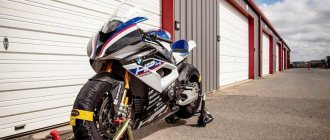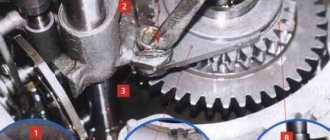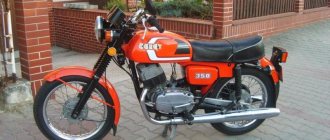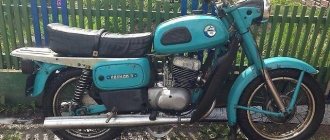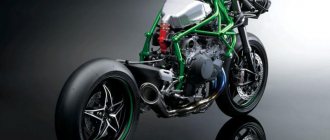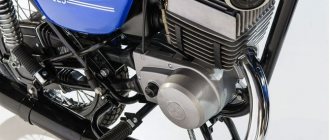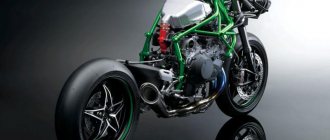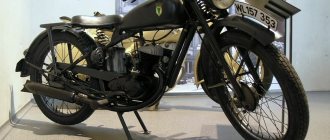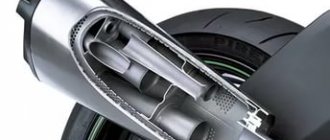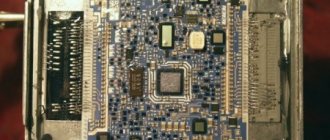- motorcycle model, BMW brand
BMW has introduced the new BMW HP4 sports bike. The new product can be considered an evolution of the BMW HP2 series, but it is equipped with an engine from the BMW S1000RR and is mainly designed for track driving.
Like the S1000RR, the HP4 engine produces over 190 hp. at 13,000 rpm and 112.5 Nm at 9750 rpm, however, the HP4 engine is tuned to increase torque at 6000-9750 rpm. The HP4 motor can operate in four modes: Rain, Sport, Race and Slick. However, unlike the S1000RR, the HP4 engine produces maximum power in all modes (including Rain). BMW engineers have slightly reconfigured the rain mode for a more even distribution of torque in the speed range from 2500 to 8000 rpm.
The BMW HP4 will be the first production motorcycle to be equipped with Dynamic Damping Control (DDC), a technology that adapts the suspension characteristics to suit the road conditions. The DDC system uses information read from the sensors and changes the level of suspension damping by adjusting the valves.
The BMW HP4 also features a new launch control system. It only works in “Slick” mode, the system allows you to accelerate as quickly as possible from a standing position. Launch control limits engine torque but maintains maximum torque at the rear wheel, so the rider can focus solely on clutch operation and not worry about throttle positioning. The launch control system also acts as an anti-wheelie, reducing torque when the front wheel starts to leave the ground.
Of course, such a bike comes with a racing anti-lock braking system as standard, but it is slightly different from the ABS on the BMW S1000RR. Thanks to the data collected in the German championship, the Bavarians improved the system’s performance in “Slick” mode. In addition, the motorcycle is equipped with Brembo monoblock calipers.
According to BMW, the HP4 model weighs 199 kg with the fuel tank 90% full, or 169 kg without fluids. For comparison, the BMW S1000RR weighs almost 205 kg when loaded, or 180 kg without fluids. The weight of the motorcycle was reduced by 2.25 kg through the use of seven-spoke forged wheels with a lighter sprocket. Another 4.5 kg was saved with the new titanium exhaust system.
The design of the BMW HP4 motorcycle is in many ways reminiscent of the BMW S1000RR, but the new product has a longer spoiler and a dark windshield. Among other things, BMW also prepared a special kit for upgrading the BMW HP4. It includes carbon fiber components, a long spoiler, adjustable running boards, brake and clutch levers, metallic blue wheels and a set of sponsor decals.
The most expensive BMW motorcycle: why the HP4 RACE is called engineering excellence
A bad equipment manufacturer is one who does not dream of creating the fastest, lightest, best motorcycle. We previously told how Ducati challenged itself to create a unique road-legal motorcycle, the Superleggera V4.
BMW also cherished the dream of creating the best motorcycle, and this is how their engineering excellence HP4 RACE was born, which is produced in limited numbers and hand-assembled. A total of 750 examples are planned, featuring a full carbon frame and carbon rims. It is known that only on a carbon frame a motorcycle loses 4 kilograms of weight. Thanks to the wheel rims, it drops another 1540 grams. As a result, the dry weight of the motorcycle is only 146 kilograms.
The project manager was Christian Gonschor. The first HP4 RACE motorcycles, called “engineering excellence”, were born in 2021 at the BMW Motorrad plant in Berlin. You will not find any turn signals, no additional lights, or a number frame on them. The engineers didn’t even consider installing anything unnecessary that doesn’t help you come first on the track. This motorcycle has only one goal - to show results.
The engine of the motorcycle is a 4-stroke, 4-cylinder, in-line engine with oil-liquid cooling and a displacement of 999 cc. Maximum torque 14,500 rpm. The engine produces 215 horsepower.
The engine is fed from a 17.5 liter gas tank. The aluminum tank is hand-satinised. The tank has a reserve of 4 liters.
BMW makes no secret of the fact that this is a track-only sportbike. The engine is run-in by specialists on a test bench prepared for this purpose, after which the results are recorded, and the first service is performed, including an oil change. Interestingly, the engine undergoes endoscopic examination, valve timing and valve clearances are adjusted. Thus, the brand new HP4 RACE bike is ready to be handed over to its new owner.
The six-speed gearbox has close ratios and HP RACE Pro gear shift assistant with a reverse shift pattern. Everything is as it should be for racing models.
And of course, a decent level of exhaust is provided by the all-titanium Akrapovic 4 x 2 x 1 WSBK system.
The 2D instrument panel provides all the information important to the driver and mechanics. The 2D recorder writes to memory and reads measured data. Users can fine-tune the DTC (Dynamic Traction Control) system to ensure excellent traction for every situation. Among the functionality, the driver can expect the ability to program engine braking (Engine Brake) and control the lifting of the front wheel (Wheelie Control), as well as a speed limiter in the pit lane (Pit-Lane Limiter) and an automatic acceleration function (Launch Control).
The motorcycle offers complete customization with a variety of adjustments, ranging from seat height to adjustable handlebar bend and footpegs. BMW also worked on ergonomics.
It is worth noting that the engineers used the maximum of developments used in world-class motorcycle racing. The motorcycle has an inverted FGR 300 Öhlins telescopic fork and a TTX 36 GP shock absorber.
Brembo GP4 PR brake calipers are responsible for safe and efficient braking, along with 6.75mm thick 320mm T-Type steel racing brake discs.
As they say at BMW, the motorcycle is designed for records. And the price for it is a record one. At the current exchange rate, perfection from BMW will cost from 5,492,000 rubles. For this money, the owner receives a “sports car” charged in every sense, created by the best minds of BMW.
Hello, good people! One way or another, spring is coming to us. I can’t help but congratulate everyone on the start of the new season. And with that, I had the opportunity to feel my hands on the new “who gives a damn” - BMW S1000RR HP4.
With your permission, I will begin a series of articles about the electronic gadgets of HP4 (a mixture of a manual with a personal assessment and other articles from the open spaces) in which I will try to describe this “teleport”, as one of the commentators on my previous essay very wittily called it. I hope these letters will be useful to those who are rushing about making a choice before purchasing, to those who want to learn about modern assistants installed on motorcycles, and to simply curious people. There was a lot of material and therefore I divided it into 3 parts: the first - a general description of the “coolness” of the device, a description of the control elements, functions and useful features - without this chapter, it seems to me, the understanding of the need for the systems described later will not be complete; the second is the modes of the motorcycle and the systems with which it is abundantly compacted; and finally, there will be a couple of videos and a purely personal opinion about the work of the one described above and a review of the motorcycle in general.
PS Some of the material may be familiar to Bikepost readers (especially in terms of descriptions of HP4 modes), so you can simply not read anything that is superfluous. I didn’t throw out a piece of information from the overall picture. Criticism is welcome.
So why HP4?
Fetishists are foaming at the mouth about anodized forged wheels, electronic sensors crammed throughout the motorcycle, square meters of carbon fiber and a capped passenger seat. Although in general terms the HP4 is practically a copy of the S1000RR. The only “advantage” for the HP4 engine was the addition of power in the mid-range of engine speeds, and that was only thanks to the racing exhaust system from the well-known Igor Akrapovich. In fact, the feature of the motorcycle is only in the “brains” and one or two systems that are new for a serial motorcycle conveyor.
So, the BMW S1000RR HP4 is perhaps the most striking representative of the “ready to race” motorcycles currently available for sale.
List of key technological features of HP4
- Fork clamp with engraved number and HP4 logo - Lightest 4-cylinder supersport motorcycle in the 1000 cc segment cm: 199 kg (90% fuel tank full, unloaded weight according to DIN standard) - Innovative suspension with DDC (Dynamic Damping Control) - Race ABS with IDM setting - DTC (Dynamic Traction) Control) with fine adjustment in Slick mode - Launch Control function - Adapted front wheel lift detection system - New rear tires, 200/55 ZR 17 - Shift assistant as standard - Lightweight titanium exhaust system with controlled acoustic valve and - Forged alloy wheels with black anodized finish - Radial monobloc Brembo brake calipers with special brake pads - Floating front brake discs - Extended two-piece engine spoiler - Single seat with cover for passenger seat - LED turn signals - Tinted windshield - Lightweight 7 Ah battery - Dynamic engine tuning - Increased mid-range torque
HP4 with Competition package
- Extended, enclosed carbon engine spoiler - Sponsor logo decal kit - Racing blue metallic rims - Carbon fairing kit with HP logo - HP carbon fuel tank cover - HP brake lever, foldable - HP clutch lever, foldable - Adjustable steering system HP footrests for pilot
Buttons
Left steering switch block 1 High beam and intermittent light signal 2 ABS control / DTC control 3 Hazard warning light control DTC setting 5 Turn 6 Horn 7 / Trim meter control / Racing-sport functions control / Setting shock absorber stiffness
Right steering wheel switch block
1 Heated grip control 2 Driving mode selection 3 Emergency ignition switch 4 Engine start / Launchcontrol
Instrument cluster
1 Panel of control and warning lamps 2 Tachometer 3 Tachometer indicator 4 Light sensor (automatically adjusts the brightness of the instrument panel backlight) with system 5 Multi-function display
Multi -function display
1 Speedometer 2 Coolant temperature 3 grip indicator 4 5 Clock 6 driving mode 7 Set DTC degree (only in SLICK mode) 8 Selected gear indicator, “N” is displayed when neutral is on. 9 Selecting driving mode The display information for the race track is activated separately.
Functions and useful features
Maintenance indicator
If the time remaining until the next maintenance does not exceed a month, the maintenance date appears briefly on the display after the Pre-Ride Check is completed.
If annual mileage is high, unscheduled maintenance may be required due to certain circumstances. If the distance for a remote service is within 1000 km, the remaining 2 kilometers are counted in 100 km increments and appear briefly on the display at the end of the Pre-Ride Check. If the maintenance period is exceeded, in addition to the date or mileage indication, the general warning lamp lights up in yellow. The message “TO” according to the Inspection regulations is constantly displayed. If the maintenance indicator is displayed more than a month before the maintenance date, then you need to set the date entered in the instrument cluster. This situation may occur if the battery has been disconnected for a long time.
Power reserve
The range shows how far you can still travel with the remaining fuel. It is only displayed once the fuel reserve has been reached. The calculation is based on average consumption and fuel filling level. If refueling is carried out after the lower fuel reserve limit has been exceeded, the total amount of fuel must be greater than the reserve and a new filling level is recognized. Otherwise, the power reserve display cannot be updated. If the motorcycle is placed on a side stand, the fuel quantity may not be determined correctly due to its tilted position. For this reason, the range is always calculated with the side stand folded. The calculated range is always an approximate value.
Odometer
The following values can be shown on the display:
— Total mileage — Single mileage 1 (Trip 1) — Single mileage 2 (Trip 2) — Cruising range (after reaching the fuel reserve)
Watch
Watches and watches in Africa, in general they are here.
Speed Threshold Warning Allows you to set the speed above which a warning will appear. If the set speed is exceeded, the tachometer indicator lights up or starts flashing at the set frequency and a warning appears.
Pre-Ride-Check
After turning on the ignition, the instrument cluster checks the warning lights and tachometer - “Pre-Ride-Check”. If the engine starts before the test is completed, the test is interrupted. The beauty is that any problem with a motorcycle in the sense of a non-working system or equipment will be described by a specific light bulb or their combination.
Circle Time
Possible data display options:
Time taken to complete the previous “LASTLAP” lap. Time of movement in the current circle. Fastest Saved Lap "BESTLAP" Fastest Lap Expected Sum of all recorded lap times Absolute Best Lap Time Maximum Speed and Minimum Speed of Displayed Race Lap Average Percentage Throttle Position, Percentage of Driving with Brake Pressed, and Number of Gear Shifts of Displayed Race Lap circle
At the start of each new lap of the race, the stopped time of the previous race lap is briefly displayed before switching to the time of the current race lap. After starting a new lap, an intermediate time is recorded every 100 m and compared with the corresponding time of the saved best lap. If the current split time is better than the split time of the best lap, then the wait for a new best time begins. The “Fastest lap” lamp turns on 1.
Additional functions for displaying system and unit settings
Rear shock absorber rebound stage (REB DDC-RE) Rear shock absorber compression stage (COM DDC-RE) Front shock absorber stiffness (DMP DDC-FR) Front shock absorber rebound stage (REB DDC-FR) Front shock absorber compression stage (COM DDC-FR) Calibration level sensor (DDC-CAL) Rotation speed for turning on/off the tachometer indicator (SFT-ON/STF-OFF) Tachometer indicator brightness (SFT-BR) Tachometer indicator flashing frequency (SFT-FL) Display backlight brightness (BRIGHT)
*A description of the indications of other systems will be given in the description of them.
This concludes the first article about HP4 electronic assistants. You can kick.
BMW HP4 review
How would you describe the latest BMW HP4 superbike? To describe it in a nutshell, it is fast and incredible at the same time. True, many citizens will be interested in the question: is the new product really better than the Ducati Panigale?
I wonder if anyone has heard of S1000RR owners complaining about it? Probably no! If you look at the question from a different angle, it turns out that at medium speeds the traction force of the new product is larger and higher, and the electronic systems have changed. But is BMW as bad as Ducati?
The new product is no different from the basic model – S1000RR. A similar conclusion suggests itself, unless you take into account the unique coloring, the presence of emblems and a serial number on the steering wheel. The performance gain is also quite noticeable and understandable. If we compare the new forged wheels with the original ones, they are 2.5 kg less than the second ones. Since the discs have become lightweight, this has a positive effect on the performance of the suspension and the steering response has increased. In addition, the manufacturer removed another 4.5 kilograms, since the exhaust system was replaced with titanium. You can learn more about the motorcycle exhaust system on the website motoholder.ru, which is actively visited by beginners and experienced motorcyclists.
All of the above goes well with other details. In particular, engine control has improved. As a result, the traction force at medium speeds has increased. Next, it’s worth talking about the changes that affected electronics. Traction control and ABS have been modified. A key part of the new motorcycle is a dynamic suspension damping system called Dynamic Damping Control. The system was developed specifically for motorcycles. The uniqueness of the system is that it is capable of changing damping both front and rear, taking into account the rider's riding style.
Can you feel the changes? Yes, of course, if you only test the bike on the track in Jerez. The bike moves easily when the rider releases the brakes, exiting a turn and starting to apply gas. When something like this happens again, you can start to believe in magic or perfect settings. On normal roads, the new system works even better, gradually adapting to potholes and potholes.
Next, it is worth noting the presence of incredible stability when the BMW HP4 resorts to hard braking. The auto giant installed other, updated brake pads. In addition, he reconfigured the ABS characteristics, borrowing it from the racing superbikes that roam the tracks in Germany. If there are racing tires, then ABS does not interfere with the actions of the motorcyclist at all. Even professional racers who recognize the inclusion system know this fact.
When else can you feel the DDC system in action? Then when the motorcyclist slows down. The front part “squats” not so quickly, but the bike itself stops, but does so reluctantly. To get the most out of a corner, you need to release the front brakes when exiting a turn, and then press on the gas.
This is how you can experience the breathtaking performance of the traction control system in action. By turning on the “SLICK” mode, you can experiment with fifteen modes. They are all different: some are annoying, while others are indifferent. If you turn on the “SPORT” mode, you will have to refuse to operate the ABS system if ordinary road tires are installed.
How does the new engine start control system behave? It keeps the speed at around 8 thousand revs. per minute, even if the throttle is open. Electronics are capable of preventing wheel slip.
The new motorcycle has much more advanced electronic systems. Compared to the 2010 S1000RR, it wins in terms of electronics, but its engine is still a likable engine. No other competitor produces an engine more powerful and better than the 4-cylinder from the Bavarians. The bike has good potential, and at the same time is flexible and easy to control.
BMW HP4 is a fast superbike. In addition, he is natural and flexible. It handles well on the road as changes have been made to the fly-by-wire throttle system, as well as chassis modifications and swingarm pivot positions.
Information about competitors
So, for example, it is worth remembering the Ducati Panigale S model, which costs 31,980 thousand dollars. Its design is magnificent, and its technical characteristics are tailored to extreme sports enthusiasts. He's basically a rocket launcher wearing an Armani suit. But even it loses to the BMW HP4.
The second competitor is the Kawasaki Ninja ZX10R. Its price is 19,430 thousand dollars. This model is tailored to the needs of Europeans, despite the fact that Japanese engineers were involved in its development. There is traction control and ABS, which is passable for track driving. The creation is inferior in power to the new product from the Bavarians.
The third competitor costs $26,875 thousand and is called Aprilia RSV4 Factory SE. It is the closest to the bike from the Bavarians, and is not inferior to it not in price, not in quality, not in speed on the track, but it does not have ABS, but it does have an anti-slip system. It is small and therefore not suitable for tall people.
Added: 12/07/2012 14:05
